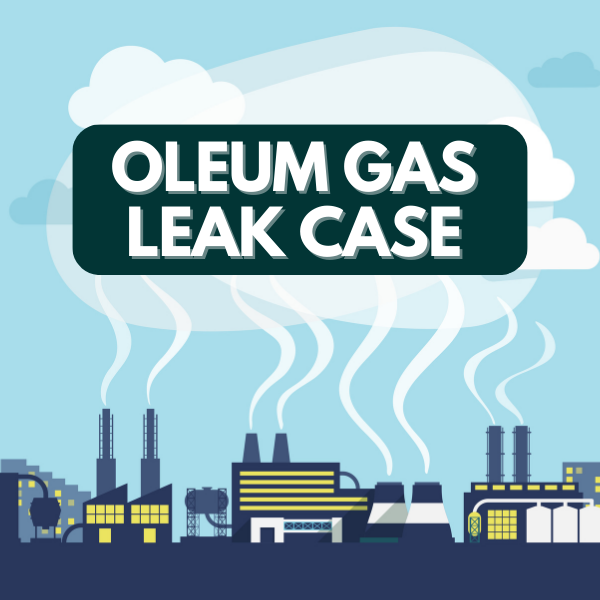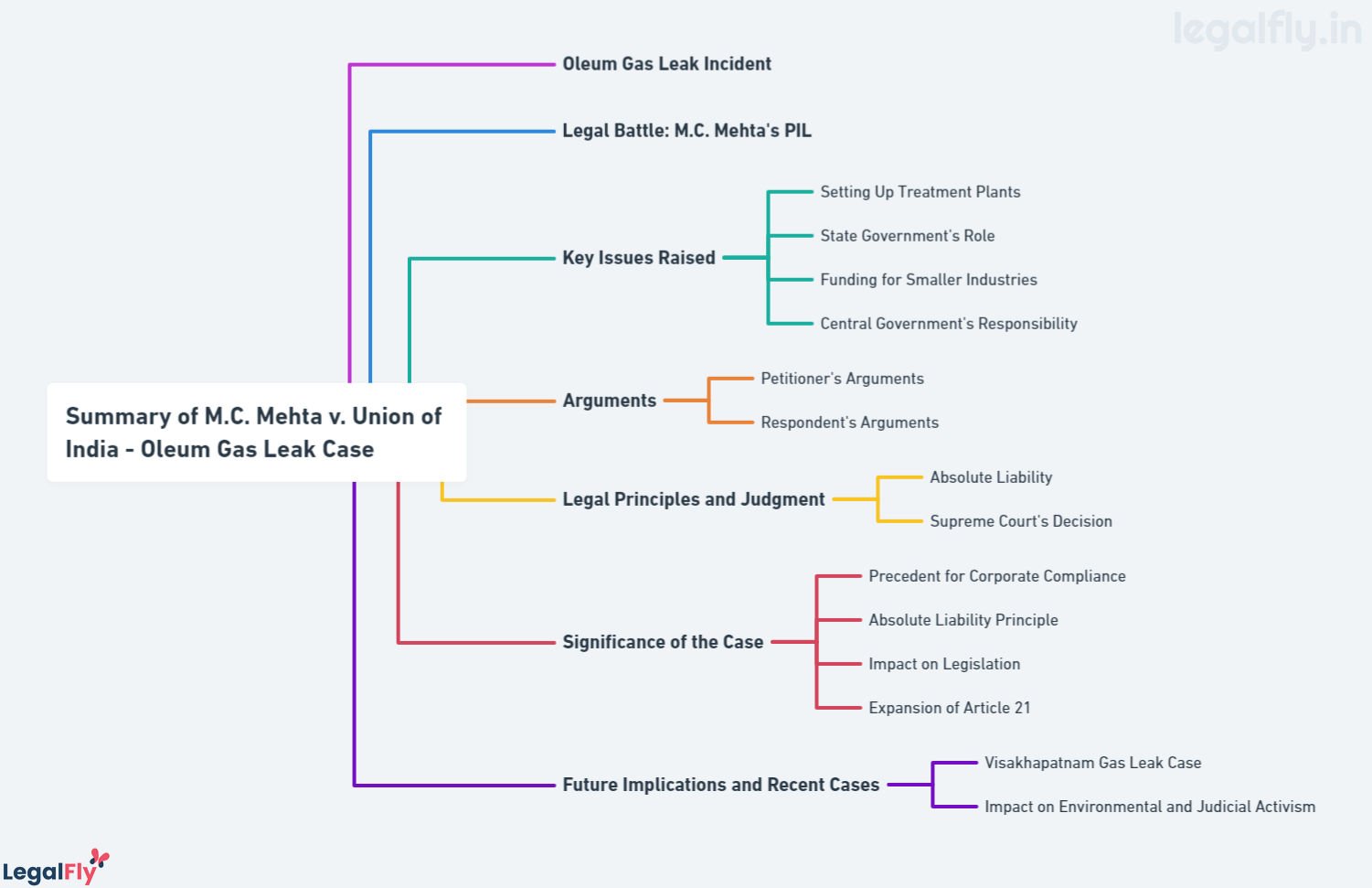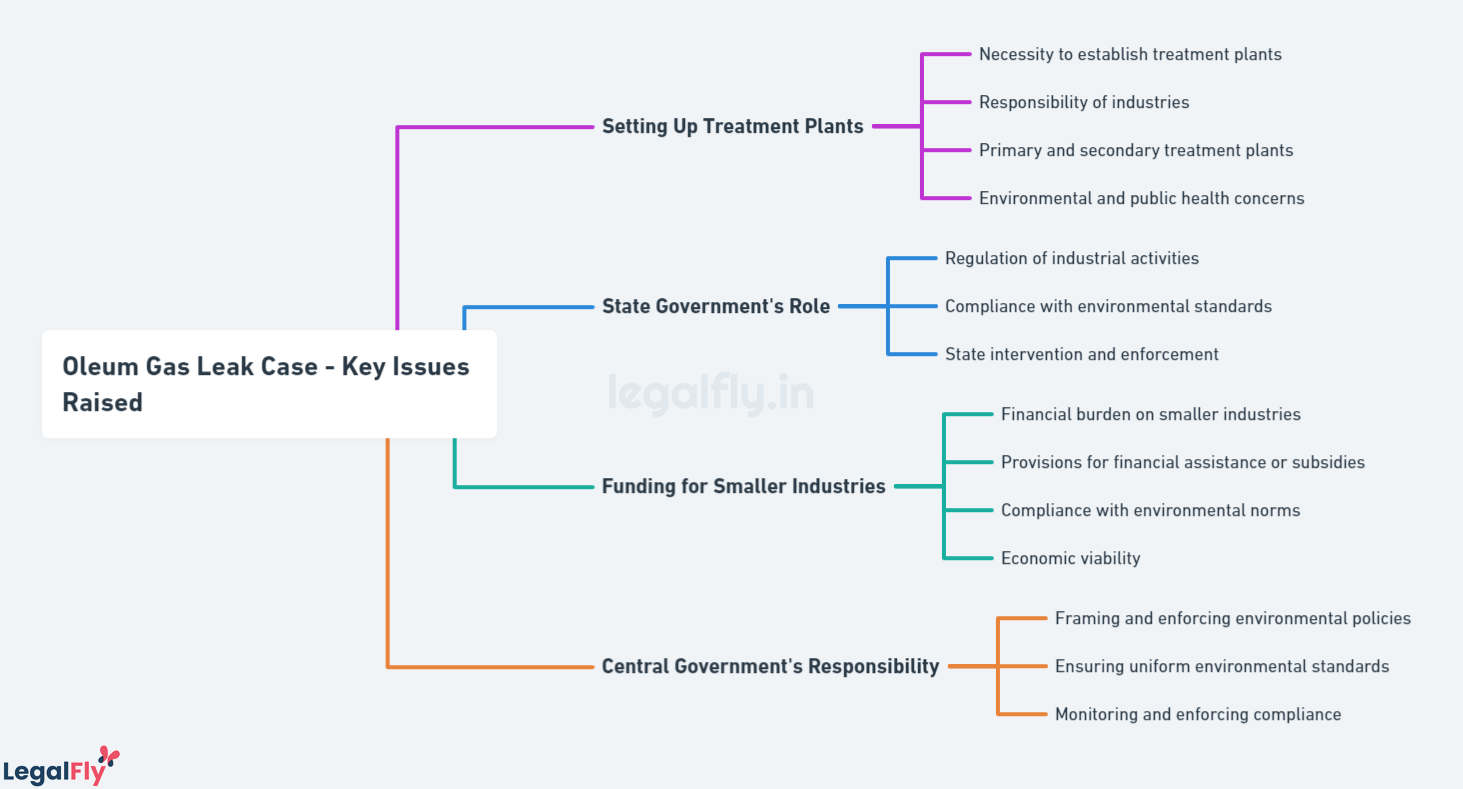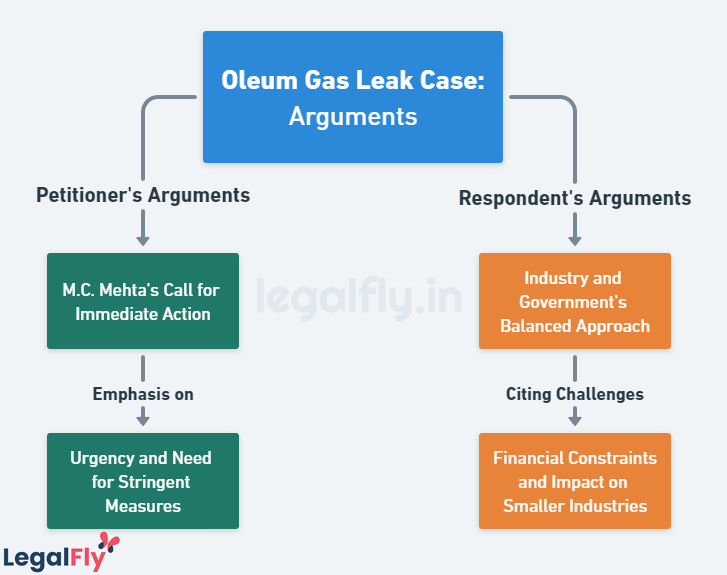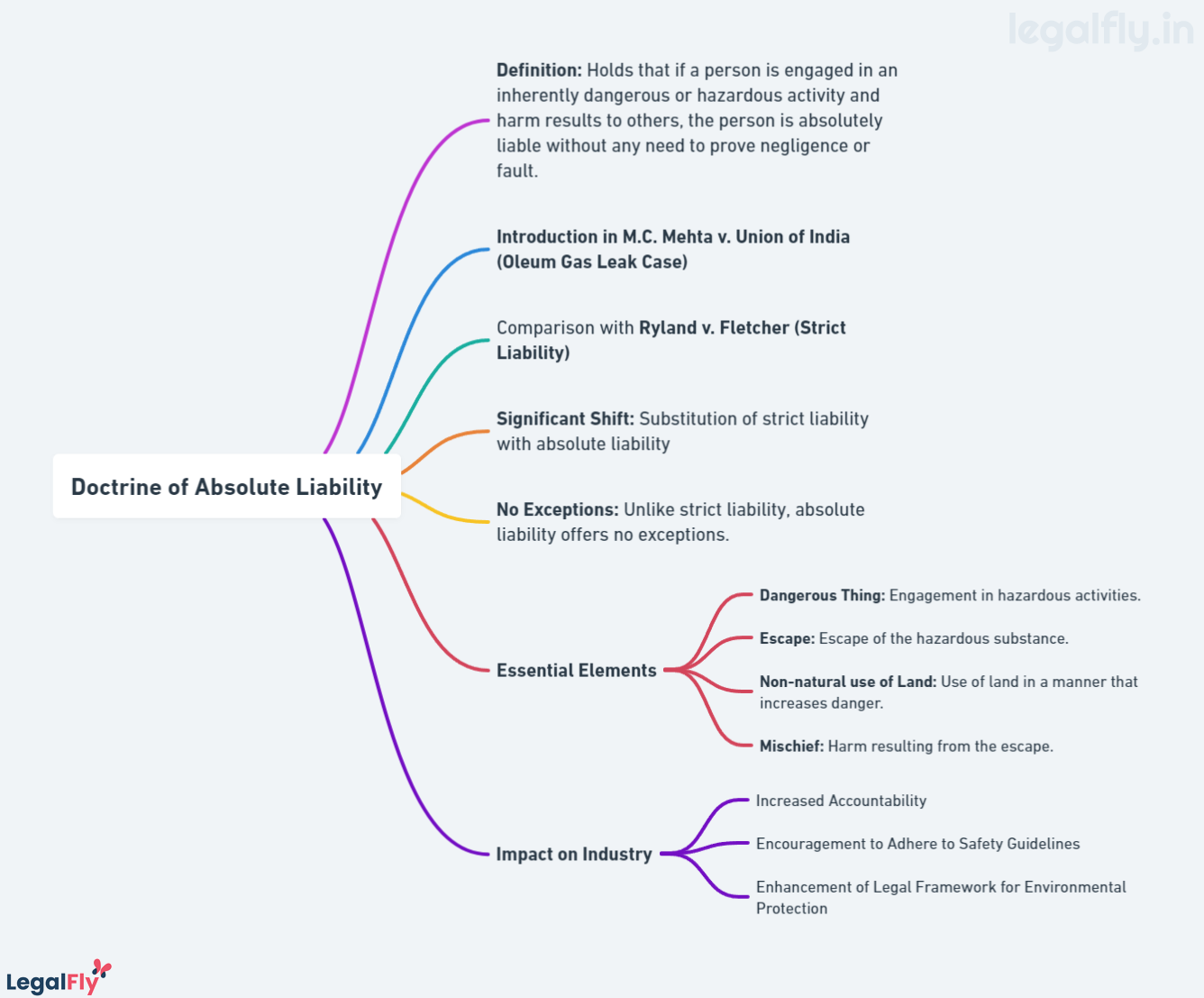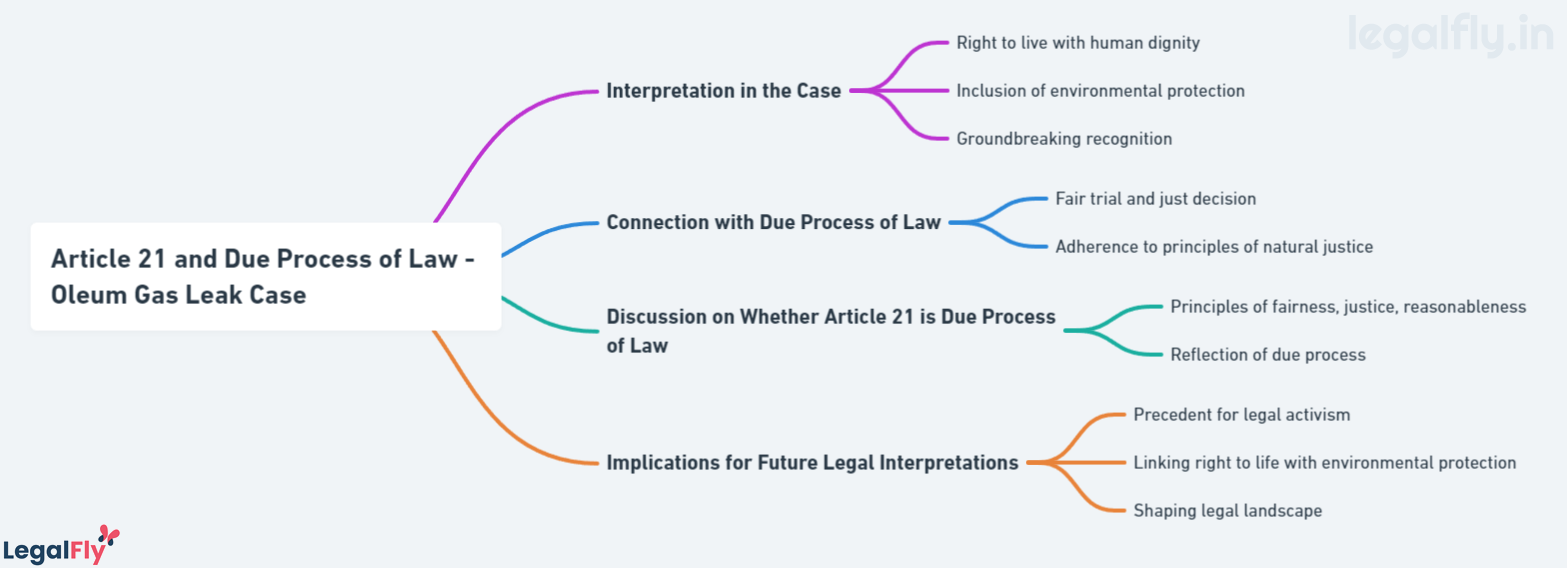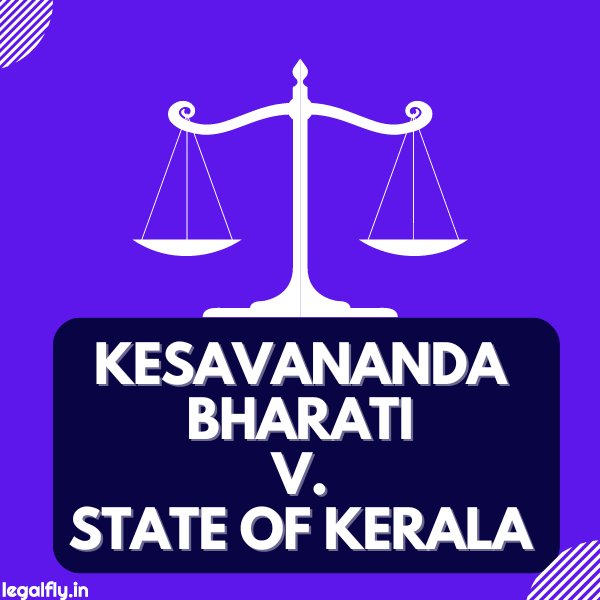Case Name: M.C. Mehta v. Union of India (Oleum Gas Leak Case) Court: Supreme Court of India Year: 1987 Citation: (1987) 1 SCC 395
Table of Contents
Introduction
The M.C. Mehta v. Union of India case, also known as the Shriram Industries Case or Oleum Gas Leak Case, is a landmark ruling highlighting the importance of environmental protection in India. On December 4, 1985, the leakage of oleum gas from Shriram Foods and Fertilizers in Delhi into the Ganga River, a sacred entity in Indian culture, led to legal proceedings that would culminate in the introduction of the Doctrine of Absolute Liability. This case raised vital questions under Articles 21 and 32 of the Indian Constitution, focusing on the doctrine of absolute liability for corporations engaging in hazardous industries.
Emerging just a year after the infamous Bhopal Gas Disaster, the ruling served as a stark reminder of the potential hazards lurking within industrial growth. It has had a lasting impact on corporate accountability, environmental protection, and policies related to industrial safety in India. This article thoroughly analyzes the incident, the legal arguments presented, the judgment, and its impact and influence on the Indian Legal System.
Background of the Oleum Gas Leak Case
The Incident: Oleum Gas Leak Incident at Shriram Food and Fertilizers Ltd.
On December 4, 1985, a catastrophic oleum gas leak occurred at Shriram Food and Fertilizers Ltd., a subsidiary of Delhi Cloth Mills Limited in Delhi. The leakage affected a large number of people, including workers and the general public, and resulted in the death of an advocate working in the Tis Hazari Court. The incident was a stark reminder of the potential hazards of operating chemical plants in populated areas, especially in the wake of the Bhopal gas tragedy.
Timeline of Events Leading to the Case
The oleum gas leak incident prompted immediate legal action. M.C. Mehta, an environmental activist and lawyer, initiated the case, fearing that the reopening of the plant would endanger the lives of workers and residents. The location of the plant in a densely populated area added to the urgency of the situation. The timeline of the events leading to the case is as follows:
- 1949: Establishment of the caustic chlorine facility, employing nearly 263 people.
- Pre-1985: Continuous emission of hazardous chemicals, creating a public nuisance.
- December 4, 1985: A significant oleum gas leak from one of Shri Ram’s units, affecting many and causing a death.
- December 6, 1985: A minor leak further escalated the situation.
- December 6, 1985: The District Magistrate of Delhi ordered Shriram to stop producing and processing hazardous chemicals within two days or appear in Court.
- Pending Case: M.C. Mehta filed a PIL to shut down and relocate the Shriram Caustic Chlorine and Sulphuric Acid Plant.
- Applications for Compensation: The Delhi Legal Aid and Advice Board and the Delhi Bar Association filed applications for compensation for those affected by the oleum gas escape.
- Referral to Larger Bench: The case was referred to a larger bench of five judges due to substantial questions of law.
Connection to Absolute Liability Tort
The case led to the establishment of the principle of absolute liability, a legal doctrine that holds entities liable for harm resulting from hazardous activities without exceptions. The incident at Shriram’s plant highlighted the need for stringent regulations and accountability in hazardous industries, leading to a broader discussion on the application of Absolute Liability Tort in Indian law.
Legal Battle: Introduction to M.C. Mehta’s Public Interest Litigation
Mahesh Chander Mehta, famously known as M.C. Mehta, a renowned environmental activist and lawyer, initiated the case against Shriram Foods and Fertilizer Industries. In this case, he filed a Public Interest Litigation (PIL) against 89 respondents, including the Union of India and various industrial bodies.
The plant was located in a densely populated area, and Mehta’s PIL sought to prevent its reopening, fearing it would endanger the lives of workers and residents. In this case, a commitment to environmental protection and public safety drove Mehta’s efforts. The case began when a matchstick caused the river to burst into flames due to harmful compounds, highlighting the severity of pollution. Mehta’s relentless pursuit of justice led to a legal battle that would have far-reaching implications for environmental law in India.
Key Issues Raised
Setting Up Treatment Plants
One of the central issues in the case was the necessity to establish treatment plants to manage and neutralize the hazardous effluents. The question revolved around the responsibility of industries to set up primary and secondary treatment plants to ensure that toxic substances did not enter the water bodies, thereby causing harm to the environment and public health.
State Government’s Role
The role of the state government in regulating industrial activities and ensuring compliance with environmental standards was another critical issue. The debate focused on how much the state government could intervene in industrial operations and the measures it needed to take to enforce environmental regulations.
Funding for Smaller Industries
The case also raised concerns about the financial burden on smaller industries in implementing environmental safeguards. The question was whether there should be provisions for financial assistance or subsidies to enable smaller industries to comply with environmental norms without compromising their economic viability.
Central Government’s Responsibility
The central government’s responsibility in framing and enforcing environmental policies was a significant aspect of the case. The issue revolved around the central government’s role in ensuring that industries across the country adhered to uniform environmental standards and the measures needed to monitor and enforce compliance.
Arguments
Petitioner’s Arguments
The petitioner, M.C. Mehta, argued for immediate and decisive action to prevent pollution. He sought a writ to inhibit respondents, including Shriram Foods and Fertilizer Industries, from releasing toxic effluents into the environment. The petitioner emphasized the situation’s urgency and the need for stringent measures to protect public health and the environment.
Respondent’s Arguments
The respondents, including industry representatives and the government, acknowledged the pollution but argued against the feasibility of establishing secondary treatment plants. They cited financial constraints and the potential impact on smaller industries as significant challenges. The respondents also emphasized the need for a balanced approach that considers environmental protection and economic development.
Legal Principles and the Judgment: M.C. Mehta v. Union of India
Summary of the Oleum Gas Leak Case Judgment
In 1988, the Supreme Court’s judgment in the Oleum Gas Leak Case held the industries responsible for proper waste treatment and emphasized the importance of environmental protection. The Court ordered the establishment of primary treatment plants and held local authorities accountable for prevention. The decision allowed the plant to reopen but imposed strict compliance safety guidelines, reflecting a careful balance between industrial development and environmental concerns.
The Law Laid Down in the Oleum Gas Leakage Case
The Court introduced the doctrine of absolute liability for corporations engaged in hazardous industries. This doctrine marked a significant departure from the traditional principles of tort law, making industries absolutely liable for any harm caused without exceptions or defenses. The ruling laid a “no-fault” liability standard, emphasizing the industries’ responsibility to ensure safety and prevent damage.
Impact on Indian Environmental Law
The Oleum Gas Leak Case’s judgment profoundly impacted Indian environmental law, setting new corporate accountability and environmental protection standards. It reinforced the principle that the right to a healthy environment is an integral part of the right to life under Article 21 of the Indian Constitution.
Key Issues Addressed
- Whether Hazardous Industries Should Operate in Populated Areas: The Court recognized the need for hazardous industries but emphasized that they must be located and operated in a manner that poses the least risk to the community.
- Regulating Mechanism for Hazardous Industries: The Court suggested the evolution of a national policy for the location and regulation of toxic industries.
- Determination of Liability and Compensation: The Court introduced a “no-fault” liability standard through the doctrine of absolute liability, making the industry absolutely liable for any harm caused without the need to prove negligence or fault.
Significance of the Case
Doctrine of Absolute Liability
- The Doctrine of Absolute Liability holds that if a person is engaged in an inherently dangerous or hazardous activity and harm results to others, the person is absolutely liable without any need to prove negligence or fault.
- Doctrine of Absolute Liability was introduced in the M.C. Mehta v. Union of India case, also known as the Oleum Gas Leak Case. In contrast, Ryland v. Fletcher established the principle of strict liability.
- The Court’s decision to substitute strict liability with absolute liability marked a significant shift in legal principles.
- Unlike strict liability, which allows certain defenses, absolute liability offers no exceptions.
- Essential Elements of Absolute Liability:
- Dangerous Thing: Engagement in hazardous activities.
- Escape: Escape of the hazardous substance.
- Non-natural use of Land: Use of land in a manner that increases danger.
- Mischief: Harm resulting from the escape.
- The doctrine has increased industry accountability, setting a legal standard for future cases involving hazardous industries.
- It has encouraged industries to adhere to safety guidelines, enhancing the legal framework for environmental protection.
Epistolary Jurisdiction
Epistolary Jurisdiction refers to the judiciary’s power to take cognizance of matters and initiate action based on letters, telegrams, or other forms of communication. It represents a significant departure from traditional legal procedures, allowing for more accessible and flexible access to justice. In the M.C. Mehta case context, this concept played a crucial role.
Definition and Origin
- Definition: Epistolary Jurisdiction allows the Court to act based on letters, telegrams, or even newspaper reports rather than formal petitions.
- Origin in India: The concept was first recognized in India in the case of S.P. Gupta v. Union of India (1981).
Application in M.C. Mehta v. Union of India
- Initiation of the Case: M.C. Mehta, an environmental lawyer, utilized this jurisdiction to file a Public Interest Litigation (PIL) against the Union of India and various industrial bodies.
- Accessibility to Justice: Epistolary Jurisdiction allowed M.C. Mehta to bypass traditional legal barriers, making the legal process more accessible and responsive to urgent environmental concerns.
- Judicial Activism: The Court’s willingness to entertain the case based on a letter reflects a form of judicial activism, where the judiciary takes a proactive role in addressing public issues.
Impact on Environmental Law
- Precedent for Future Cases: The use of Epistolary Jurisdiction in this case set a precedent for future environmental cases, allowing activists and concerned citizens to approach the Court more easily.
- Promotion of Environmental Justice: By enabling the Court to act on letters or other informal communications, it has facilitated the pursuit of environmental justice, particularly in urgent and significant matters.
Comparison with Traditional Legal Procedures
- Traditional Procedures: Typically require formal petitions and adherence to specific formats and may involve significant costs.
- Epistolary Jurisdiction: Simplifies the process, allowing for informal communication, often without legal representation.
Public Liability Insurance Act, 1991
The M.C. Mehta case’s landmark ruling, which introduced the doctrine of absolute liability, laid the groundwork for the Public Liability Insurance Act 1991. This Act was a response to the need for a legal framework to address liability and compensation in cases of industrial accidents, particularly highlighted by incidents like the Oleum Gas Leak and the Bhopal Gas Tragedy. The objective of the Act is to provide immediate relief to individuals affected by accidents involving hazardous substances. It requires industries handling such substances to take out insurance policies, ensuring immediate relief to the affected persons without waiting for lengthy legal procedures. The Act applies to all owners associated with producing or handling hazardous chemicals, encouraging industries to adhere to safety guidelines and take preventive measures.
The influence of the M.C. Mehta case on this legislation is profound, as the judgment set a precedent for holding industries absolutely liable, directly shaping the Act’s formulation. The Act’s impact on industrial practices includes promoting corporate responsibility and providing a financial mechanism to compensate victims promptly. However, some critics argue that the Act’s scope is limited and only covers some hazardous industries, and there have been challenges in implementation and enforcement. Despite these criticisms, the legacy of the M.C. Mehta case continues to be cited and has lasting implications for environmental law and policy in India. The Public Liability Insurance Act 1991 is a significant legislative response to the principles established in the M.C. Mehta case, playing a crucial role in shaping industrial responsibility and environmental protection in India.
Article 21 and Due Process of Law
The M.C. Mehta v. Union of India case was pivotal in interpreting Article 21 of the Indian Constitution, which guarantees the right to life and personal liberty. The judgment expanded the scope of Article 21 to include the right to a healthy environment, setting a precedent for future legal interpretations.
Interpretation in the Case
In this landmark case, the Supreme Court held that the right to live with human dignity, encompassed in Article 21, includes the right to protect and preserve the environment. The Court’s interpretation was groundbreaking, recognizing that any act endangering or impairing the quality of life, such as pollution or environmental degradation, violates Article 21. This interpretation has had far-reaching implications, influencing subsequent judgments and shaping environmental law in India.
Connection with Due Process of Law
The M.C. Mehta case also shed light on the concept of due process of law within the Indian legal system. The Court ensured that both parties were allowed to defend their positions and submit their statements and evidence. The decision was reached after a comprehensive examination of the facts and legal principles, adhering to the principles of natural justice. This adherence to due process reinforced the legitimacy of the Court’s decision and contributed to the development of jurisprudence related to environmental protection.
Discussion on Whether Article 21 is Due Process of Law
The case sparked a broader discussion on whether Article 21 embodies the concept of due process of law. While the Indian Constitution does not explicitly mention “due process,” the principles of fairness, justice, and reasonableness are inherent in Article 21. The M.C. Mehta case exemplified these principles by ensuring a fair trial and a just decision, reflecting the essence of due process.
Implications for Future Legal Interpretations
The interpretation of Article 21 in the M.C. Mehta case has set a precedent that continues to influence Indian legal thought. The judgment has opened doors for legal activism and public interest litigation in environmental matters by linking the right to life with environmental protection. The principles laid down in this case continue to guide courts in interpreting Article 21, shaping the legal landscape and reinforcing the importance of environmental protection within the framework of constitutional rights.
Future Implications and Recent Case
Visakhapatnam Gas Leak Case (2020)
The Visakhapatnam gas leak, also known as the Vizag gas leak, occurred at the LG Polymers chemical plant in Visakhapatnam, India, on May 7, 2020. The incident was caused by a malfunction in the cooling system of styrene storage tanks, resulting in the death of 13 people and injuring over 1,000.
Incident: The leak happened during the early morning hours, spreading a vapor cloud over a radius of around 3.0 km, affecting nearby areas and villages. Preliminary investigations concluded that the accident was likely due to insufficient maintenance, improper storage, and operation errors.
Judgment: The local police filed a first information report (FIR) against LG Polymers, allowing for possible charges of making the atmosphere harmful to health and negligent conduct. The Government of Andhra Pradesh announced compensation for the deceased and injured, and a budget of 30 crores (US$3.8 million) was allocated for all those affected.
Legacy of M.C. Mehta v. Union of India
The Oleum Gas Leak Case ruling introduced the Doctrine of Absolute Liability, holding industries absolutely liable for any harm caused without any defenses. This principle was applied in the Visakhapatnam case, where the company was held absolutely liable.
The Visakhapatnam gas leak incident has brought attention to the importance of environmental laws and regulations, highlighting the need for stricter enforcement and compliance. The lack of environmental clearance for the plant and the violation of safety norms underscores this necessity. Simultaneously, the case reinforces the judiciary’s role in protecting the environment and holding corporations accountable. It emphasizes the need for legal frameworks that ensure corporate responsibility and environmental protection, following the principles laid down in the M.C. Mehta case. This convergence of environmental and judicial activism serves as a reminder of the interconnectedness of legal oversight and environmental stewardship in India.
Comparative Analysis: Oleum Gas Leak Case vs. Bhopal Gas Disaster
The M.C. Mehta v. Union of India (Oleum Gas Leak Case) and the Bhopal Gas Disaster are two significant incidents that have influenced environmental law in India. This comparative analysis clearly explains both cases’ legal principles, outcomes, and preventive measures. By examining these incidents, law students, teachers, lawyers, and other legal professionals can gain valuable insights into the complexities of industrial safety regulations and environmental protection in the Indian legal context.
| Aspect | M.C. Mehta v. Union of India (Oleum Gas Leak Case) | Bhopal Gas Disaster |
| Incident Date | December 4, 1985 | December 2-3, 1984 |
| Location | Delhi, India | Bhopal, Madhya Pradesh, India |
| Chemical Involved | Oleum Gas | Methyl Isocyanate (MIC) |
| Company Involved | Shriram Foods and Fertilizers | Union Carbide Corporation |
| Casualties | One death, several affected | Over 3,800 deaths, thousands affected |
| Legal Outcome | Doctrine of Absolute Liability introduced | Settlement reached, criminal charges |
| Impact on Law | Led to the Environment Protection Act of 1986 | Influenced laws on industrial safety |
| Compensation | Court-ordered compensation | $470 million settlement |
| Environmental Impact | Localized impact | Long-term environmental damage |
| Public Reaction | Concern over industrial safety | Global outrage, protests |
| Preventive Measures Taken | Strict safety guidelines imposed | Changes in industrial safety laws |
Key Insights:
- Scale of Tragedy: The Bhopal Gas Disaster was one of the world’s worst industrial disasters, with a massive loss of life and long-term health effects. At the same time, the Oleum Gas Leak was a more minor incident but significant in legal terms.
- Legal Implications: The Oleum Gas Leak Case introduced the Doctrine of Absolute Liability, a landmark in Indian environmental law. The Bhopal Gas Disaster led to changes in industrial safety regulations.
- Compensation: The compensation mechanisms differed in both cases, with a substantial settlement in the Bhopal case and court-ordered compensation in the Oleum Gas Leak case.
- Environmental Impact: The environmental impact of the Bhopal Gas Disaster was far-reaching and continues to affect the area, while the Oleum Gas Leak had a more localized effect.
Conclusion
The M.C. Mehta v. Union of India judgment is a landmark decision that has left a lasting mark on Indian environmental law. Establishing the Doctrine of Absolute Liability and broadening the interpretation of Article 21 has influenced many subsequent legal decisions. This case highlighted the importance of individual rights and environmental protection and set the stage for future environmental cases in India. Its ongoing impact on corporate accountability, environmental awareness, and legal oversight emphasizes the case’s continued relevance in the Indian legal system. It’s a constant reminder of the need to find the right balance between growth and protecting our environment.
References: https://en.wikipedia.org/wiki/M._C._Mehta_v._Union_of_India https://main.sci.gov.in/jonew/judis/9120.pdf

